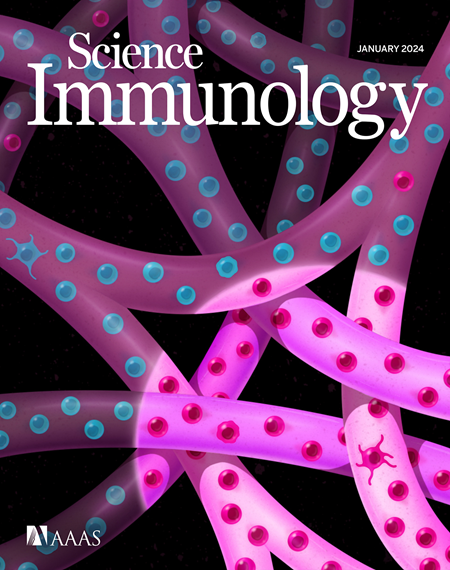GGNBP2 regulates MDA5 sensing triggered by self double-stranded RNA following loss of ADAR1 editing
IF 16.3
1区 医学
Q1 IMMUNOLOGY
引用次数: 0
Abstract
Adenosine-to-inosine (A-to-I) editing of double-stranded RNA (dsRNA) by ADAR1 is an essential modifier of the immunogenicity of cellular dsRNA. The role of MDA5 in sensing unedited cellular dsRNA and the downstream activation of type I interferon (IFN) signaling are well established. However, we have an incomplete understanding of pathways that modify the response to unedited dsRNA. We performed a genome-wide CRISPR screen and showed that GGNBP2, CNOT10, and CNOT11 interact and regulate sensing of unedited cellular dsRNA. We found that GGNBP2 acts between dsRNA transcription and its cytoplasmic sensing by MDA5. GGNBP2 loss prevented induction of type I IFN and autoinflammation after the loss of ADAR1 editing activity by modifying the subcellular distribution of endogenous A-to-I editing substrates and reducing cytoplasmic dsRNA load. These findings reveal previously undescribed pathways to modify diseases associated with ADAR mutations and may be determinants of response or resistance to small-molecule ADAR1 inhibitors.
GGNBP2调节ADAR1编辑缺失后自身双链RNA引发的MDA5感应
ADAR1 对双链 RNA(dsRNA)进行腺苷转肌苷(A-to-I)编辑是细胞 dsRNA 免疫原性的重要调节因子。MDA5 在感知未经编辑的细胞 dsRNA 和下游激活 I 型干扰素(IFN)信号传导中的作用已得到公认。然而,我们对改变对未经编辑的dsRNA的反应的途径的了解并不全面。我们进行了一次全基因组的 CRISPR 筛选,结果显示 GGNBP2、CNOT10 和 CNOT11 相互作用并调控对未经编辑的细胞 dsRNA 的感应。我们发现 GGNBP2 介于 dsRNA 转录和 MDA5 的细胞质感应之间。GGNBP2 的缺失通过改变内源性 A 到 I 编辑底物的亚细胞分布和减少细胞质 dsRNA 负荷,防止了 ADAR1 编辑活性缺失后 I 型 IFN 的诱导和自身炎症。这些发现揭示了以前未曾描述过的改变与 ADAR 突变有关的疾病的途径,并可能是决定对小分子 ADAR1 抑制剂的反应或抗性的因素。
本文章由计算机程序翻译,如有差异,请以英文原文为准。
求助全文
约1分钟内获得全文
求助全文
来源期刊

Science Immunology
Immunology and Microbiology-Immunology
CiteScore
32.90
自引率
2.00%
发文量
183
期刊介绍:
Science Immunology is a peer-reviewed journal that publishes original research articles in the field of immunology. The journal encourages the submission of research findings from all areas of immunology, including studies on innate and adaptive immunity, immune cell development and differentiation, immunogenomics, systems immunology, structural immunology, antigen presentation, immunometabolism, and mucosal immunology. Additionally, the journal covers research on immune contributions to health and disease, such as host defense, inflammation, cancer immunology, autoimmunity, allergy, transplantation, and immunodeficiency. Science Immunology maintains the same high-quality standard as other journals in the Science family and aims to facilitate understanding of the immune system by showcasing innovative advances in immunology research from all organisms and model systems, including humans.
 求助内容:
求助内容: 应助结果提醒方式:
应助结果提醒方式:


